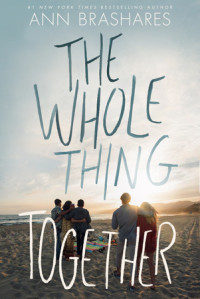 “If you put both sides together, it would kind of make a whole. But you never put both sides together.”
“If you put both sides together, it would kind of make a whole. But you never put both sides together.”
Step-siblings Sasha and Ray are seventeen years old. Sasha’s dad and Ray’s mom were married, but divorced and married other people, who became Sasha’s mom and Ray’s dad. So Sasha and Ray aren’t related. Are you with me so far? Good.
Sasha’s dad Rodger is rich. Ray’s mom Lila isn’t. Manhattan, Brooklyn. Day, night. Love, hate…or rather, hate, hate. Because Sasha’s dad and Ray’s mom can’t stand each other. Hate, loathe and abominate each other, to be precise. Yet they share a beach house in the Hamptons that neither could give up, where they switch on and off every summer week/ school weekend like a seldom used faucet. Sasha and Ray have shared a bedroom their whole life, but they’ve never met. Each week or weekend one has the room, and then when the switch is made, the other takes over. They share books, LEGOs, flip-flops, toiletries, even half-sisters. And now Sasha and Ray are starting to wonder if they should share a coffee and meet each other face-to-face.
Ann Brashares, who crafted the incredible Sisterhood of the Traveling Pants series (and its spin-offs), digs into the world of divorce, remarriage, and the shrapnel left behind in The Whole Thing Together. And it’s a masterpiece of love, pain, longing and redemption. Because Whole Thing isn’t just about Sasha and Ray, it’s about their whole family. Er, families. You know what I mean.
Less than half way through the first chapter, and I was sucked in. (Exactly like the Sisterhood series, btw.) Brashares hasn’t lost her fine touch with characters, dialogue, and crafts a believable world where everything’s fine, except for the stuff that isn’t. The story is told through the eyes of the children from the Rodger/Lila marriages; Sasha, Ray, and their three half-sisters Emma (the perfect daughter), Mattie (the beautiful mess), and Quinn (the spiritual summer child). This works to give a fuller feel to the story, and keeps the first-person narrative right where it needs to be at any given time. These changes of perspective flow easily, making for a light, easy read even when things get serious.
Another thing that Brashares does well is describe locations. Here the Hamptons are a vibrant dichotomy of mansions hidden from view, glorious beaches, and gorgeous farms. Surfers and shops where everything is triple the price elsewhere. An area where gentrification has hit hard, and is slowly taking over, but hasn’t quite extinguished everything that made the place so desirable at the start. Prep schools and public schools are different, but the same. And Brooklyn is the “real” Brooklyn – Lila and her professor husband have definitely lived there long before Park Slope became a thing – with hint of the hipster haven peeking around the edges. Brashares’ ability to dig into the details, instead of painting with a wide brush, makes everything more real, more lived-in, while also giving off a love-letter vibe to these locations. I’ve never been to the Hamptons, but now I really want to wander around and find a farmer’s market that sells blueberries.
With the different locations, comes different stories from each character, and Brashares’ uncanny knack for getting into the minds of her characters makes each one compelling in its own right. While Sasha and Ray struggle to figure out what they should mean to each other, twenty-two year old Emma has fallen in love, but doesn’t know how to tell her parents. Nineteen year old Mattie has hit a dreaded “what now?” moment in her life, and twenty-one year old Quinn…well, there’s a problem she has, but it’s tough to suss out.
Okay, it’s not really that hard; she feels more than most, and as the story unfolds and things get complicated (as things always do), Quinn struggles to keep herself tethered to her world. For me, Quinn is a bit too ethereal, a touch too “special” to be taken seriously as a character. She’s more of a catalyst in human form, someone each character cherishes for the pure and simple reason that she exists. “Quinn was their special magic.” That’s lovely, but while getting the Quinn’s-eye-view is always intriguing, it’s also often confusing and messy. A bit too much mumbo-jumbo, and not enough clear-eyed coming into herself. I was waiting for a breakthrough that never quite happened.
As for the never-quite of it all, the ending of Whole Thing is rather abrupt, in a “wait, it’s over now?” kind of way. But after that initial shock, it feels right. Like a world we got only a brief glimpse of. Just a small piece of their struggles, even though we got to know them well during that time. Perhaps that’s because a sequel is in the works? I guess only Quinn knows for sure. But the story works well as a stand-alone if a part two isn’t in the cards.
Yes, The Whole Thing Together a bit too Stevie Nicks in some spots, a little overly schmoopy in others. But it socked me right in the heart and I couldn’t put it down. I’m betting you won’t be able to either.
[Random House, 2017]
